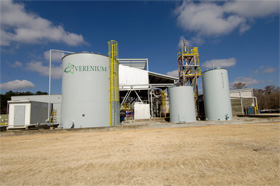 Indications are that the Bush administration will make changes to the ethanol tariff in its budget to Congress scheduled to be released Monday. Earlier this week, Energy Secretary Sam Bodman hinted that the White House’s 2009 budget may propose scaling back or eliminating the 54-cent-a-gallon import tariff.
Indications are that the Bush administration will make changes to the ethanol tariff in its budget to Congress scheduled to be released Monday. Earlier this week, Energy Secretary Sam Bodman hinted that the White House’s 2009 budget may propose scaling back or eliminating the 54-cent-a-gallon import tariff.
In a speech to the U.S. Chamber of Commerce, Bodman said, “I would just say I think that there are advantages to having had the kind of both subsidies and tariffs that have helped protect this industry. I believe that, the best I can tell, this industry is pretty close to being able to stand on its own.”
 Senator Chuck Grassley (R-IA) issued a statement.saying that removing the tariff would ultimately result in subsidizing Brazilian ethanol. “I can’t figure out why Secretary Bodman would want the United States to risk becoming dependent on Brazilian ethanol when we’re already dependent on Middle East oil. His comments really do a disservice to President Bush who has been the most pro-ethanol president we’ve ever had,” Grassley said.
Senator Chuck Grassley (R-IA) issued a statement.saying that removing the tariff would ultimately result in subsidizing Brazilian ethanol. “I can’t figure out why Secretary Bodman would want the United States to risk becoming dependent on Brazilian ethanol when we’re already dependent on Middle East oil. His comments really do a disservice to President Bush who has been the most pro-ethanol president we’ve ever had,” Grassley said.
“In addition, the United States already provides duty-free treatment for Brazilian ethanol that is merely dehydrated in the Caribbean Basin Initiative countries. Brazil has yet to make full use of this program. I don’t see why we should bend over backwards to provide yet more duty-free treatment for Brazil’s ethanol producers.”



 Ethanol poured more than $2.2 billion in revenues into local, state, and federal tax coffers in 2006… and is expected to go over $3 billion this year.
Ethanol poured more than $2.2 billion in revenues into local, state, and federal tax coffers in 2006… and is expected to go over $3 billion this year.  Big announcements for cellulosic ethanol recently prove that the next generation of the biofuel is here today.
Big announcements for cellulosic ethanol recently prove that the next generation of the biofuel is here today.  Some prominent Democratic mayors in California have taken to the road to campaign for presidential hopeful Sen. Hillary Clinton in a bus fueled by biodiesel.
Some prominent Democratic mayors in California have taken to the road to campaign for presidential hopeful Sen. Hillary Clinton in a bus fueled by biodiesel. As we mentioned here before, one of the best ways to make biodiesel more mainstream is to get it into the mainstream of the trucking industry in this country.
As we mentioned here before, one of the best ways to make biodiesel more mainstream is to get it into the mainstream of the trucking industry in this country. REG’s Retail Biodiesel Blending Program, announced at the NATSO Show in Orlando, Fla., offers truck-stop operators both biodiesel injection equipment and a regular supply of high-quality biodiesel.
REG’s Retail Biodiesel Blending Program, announced at the NATSO Show in Orlando, Fla., offers truck-stop operators both biodiesel injection equipment and a regular supply of high-quality biodiesel. Biodiesel could save Americans billions of dollars, while making the country cleaner… that according to a spokesman for a Mississippi-based biodiesel manufacturer.
Biodiesel could save Americans billions of dollars, while making the country cleaner… that according to a spokesman for a Mississippi-based biodiesel manufacturer. A demonstration-scale cellulosic ethanol facility in Jennings, Louisiana is getting closer to completion.
A demonstration-scale cellulosic ethanol facility in Jennings, Louisiana is getting closer to completion.  In February 2007, Verenium broke ground on a 1.4 million gallon-per-year demonstration plant right next to its Jennings pilot site. The company hopes to finish this second plant before April, where Verenium will fine-tune its enzymes, ethanol production and feedstocks (primarily local cane bagasse) before it goes full-scale with a third plant.
In February 2007, Verenium broke ground on a 1.4 million gallon-per-year demonstration plant right next to its Jennings pilot site. The company hopes to finish this second plant before April, where Verenium will fine-tune its enzymes, ethanol production and feedstocks (primarily local cane bagasse) before it goes full-scale with a third plant. Entrants can submit a :30 second video to
Entrants can submit a :30 second video to